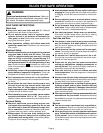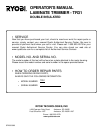
Page 15
MAINTENANCE
WARNING:
When servicing use only identical Ryobi replacement
parts. Use of any other parts may create a hazard or
cause product damage.
BRUSH REPLACEMENT
See Figure 16.
Your trimmer has externally accessible brush assemblies
that should periodically be checked for wear. Proceed as
follows when replacement is required:
■ UNPLUG YOUR TRIMMER.
WARNING:
Failure to unplug your trimmer could result in accidental
starting causing serious injury.
■ Remove brush cap with a flat blade screwdriver. Brush
assembly is spring loaded and will pop out when you
remove brush cap.
■ Remove brush assembly (brush and spring).
■ Check for wear. If worn, always replace in pairs. DO
NOT replace one side without replacing the other
.
■ Reassemble using new brush assemblies. Make sure
curvature of brush matches curvature of motor and that
brush moves freely in brush tube.
■ Make sure brush cap is oriented correctly (straight) and
replace.
■ Tighten brush cap securely. DO NOT over torque.
PROPER CARE OF CUTTERS
Get faster more accurate cutting results by keeping cutters
clean and sharp. Remove all accumulated pitch and gum
from cutters after each use.
When sharpening cutters, sharpen only the inside of the
cutting edge. Never grind the outside diameter. Be sure
when sharpening the end of a cutter to grind the clearance
angle the same as originally ground.
PROPER CARE OF COLLET
From time to time, it also becomes necessary to clean your
collet and collet nut. To do so, simply remove collet nut from
collet and clean the dust and chips that have collected. Then
return collet nut to its original position.
GENERAL
Avoid using solvents when cleaning plastic parts. Most
plastics are susceptible to damage from various types of
commercial solvents and may be damaged by their use. Use
clean cloths to remove dirt, carbon dust, etc.
Fig. 16
BRUSH CAP
BRUSH CAP
BRUSH
ASSEMBLY
BRUSH
ASSEMBLY
WARNING:
Do not at any time let brake fluids, gasoline, petroleum-
based products, penetrating oils, etc. come in contact
with plastic parts. They contain chemicals that can
damage, weaken, or destroy plastic.
When electric tools are used on fiberglass boats, sports cars,
wallboard, spackling compounds, or plaster, it has been
found that they are subject to accelerated wear and possible
premature failure, as the fiberglass chips and grindings are
highly abrasive to bearings, brushes, commutators, etc.
Consequently it is not recommended that this tool be used
for extended work on any fiberglass material, wallboard,
spackling compounds, or plaster. During any use on these
materials, it is extremely important that the tool is cleaned
frequently by blowing with an air jet.
WARNING:
Always wear safety goggles, or safety glasses with side
shields during power tool operation or when blowing dust.
If operation is dusty, also wear a dust mask.
LUBRICATION
All of the bearings in this tool are lubricated with a sufficient
amount of high grade lubricant for the life of the unit under
normal operating conditions. Therefore, no further lubrication
is required.


















